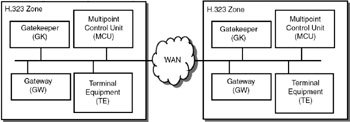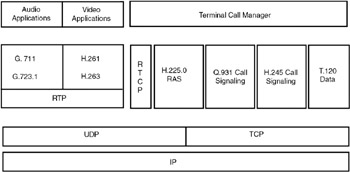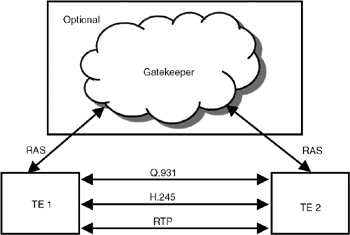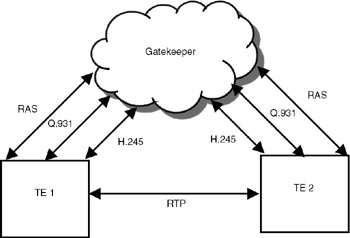34.3 PROTOCOL STANDARDS FOR MULTIMEDIA COMMUNICATIONS OVER IP NETWORKS
|
| < Day Day Up > |
|
34.3 PROTOCOL STANDARDS FOR MULTIMEDIA COMMUNICATIONS OVER IP NETWORKS
For multimedia communication over IP networks, signaling is the most important aspect. During the initial days of voice and video conferencing over the Internet, proprietary signaling protocols were used for communication between multimedia PCs, because of which the products of different vendors did not interoperate. The H.323 set of protocol standards was released by ITU-T to bring in standardization to make interoperability feasible.
| Note | Until a few years ago, for voice over IP, proprietary protocols were used. Hence, software supplied by the same vendor had to run on both ends for two users to communicate with each other. |
H.323 is the standard set of protocols for multimedia communication over networks that do not offer guaranteed quality of service (QoS), such as LANs and the Internet. Now, a large number of vendors offer products that support H.323.
The H.323 series of standards specifies the protocols for multimedia communication over networks that do not offer guaranteed quality of service. Such networks are Ethernet-based local area networks and the Internet.
An H.323 network is shown in Figure 34.2. The various components of H.323 network are:
-
Terminal equipment
-
Multipoint control unit
-
Gateway
-
Gatekeeper

Figure 34.2: H.323 network.
Terminal equipment (TE): The TE provides a user with data/voice/video services over an H.323 network. The TE can be a multimedia PC, an IP phone, a fax machine, and so forth.
Multipoint controller unit (MCU): This is a conference server that allows three or more H.323 TEs to connect and participate in a conference. MCU contains a multipoint controller to manage the functions and capabilities of the TEs for conference calls and processors to process data and audio/video streams.
Gateway: Gateway makes H.323 TE on a LAN available to a WAN or another gateway. It provides the necessary protocol conversion, for example, to enable an H.323 TE to talk to a telephone connected to the PSTN.
Gatekeeper: Gatekeeper provides the network services to the H.323 terminals, MCUs and gateways. Its functions are (a) control the number and type of connections; (b) help route a call to the correct destination; and (c) determine the network addresses for incoming calls. Every H.323 gatekeeper controls one H.323 zone.
The protocol stack that runs on an H.323 terminal is shown in Figure 34.3. The same stack also runs on the MCU, gateway, and gatekeeper. The various protocol standards used in H.323 are as follows:

Figure 34.3: H.323 terminal-side protocol stack.
The four network elements in a H.323 network are (a) terminal equipment; (b) multipoint control unit; (c) gateway; and (d) gatekeeper.
H.225.0: This standard is to format data, audio, video, and control streams for outputting to network and retrieve from the network using packet format of RTP (Realtime Transport Protocol) and RTCP (Real Time Control Protocol) for:
-
RAS (registration, admission, and status) control to communicate with the gatekeeper
-
Error detection
-
Logical framing to convert audio/video to bit streams
-
Sequence numbering
Q.931: This is a datalink layer protocol for establishing connections and framing data. It provides logical channels within a physical channel.
H.245: This standard defines the call control procedures to enable two H.323 terminals to talk to each other. In addition to establishing audio/video connections, it also handles signaling, flow control, capability negotiation, and codec selection. Bit rate, frame rate, picture format, and algorithms to be used for coding are negotiated using this protocol.
G.711: This standard defines audio coding at 48, 56, and 64 kbps data rates.
G.723: This standard defines audio coding at 5.3 and 6.3 kbps data rates.
H.261: This standard defines video coding at 64 kbps data rate.
The H.323 series of standards specifies the various protocols for call control such as call establishment and disconnection, formats for video coding, low bit rate coding techniques to be used for audio and video, and two special protocols to achieve real-time audio/video communication.
H.263: This standard defines the format and algorithms to be used for video coding. The formats supported are Common Interchange Format (CIF), Quarter CIF (QCIF), Semi-Quarter CIF (SQCIF) picture formats.
T.120: This standard is defined for data applications.
RTP, RTCP: These are special protocols defined for real-time audio/video streaming applications.
| Note | The protocols RTP and RTCP run above the UDP, and not TCP. As compared to TCP, UDP is a lightweight protocol, and hence processing overhead is reduced if UDP is used. |
34.3.1 Call Models
In an H.323 network, calls can be established in two ways. In direct call model shown in Figure 34.4, two TEs can communicate with each other directly. The gatekeepers are optional; if present, they provide RAS functionality only. The signaling is carried out directly between the two TEs. In Figure 34.5, the gatekeeper-routed call model is shown. In this model, the signaling is carried out through the gatekeepers, and the data streams (audio/video) are exchanged between the TEs.

Figure 34.4: Direct call model of H.323.

Figure 34.5: Gatekeeper-routed call model of H.323.
In an H.323 network, two types of call models are used. In direct call model, two terminals can talk directly with each other. In gatekeeper-routed call model, signaling is done through the gatekeeper, and the audio/video data is exchanged between the terminals directly.
|
| < Day Day Up > |
|
EAN: 2147483647
Pages: 313